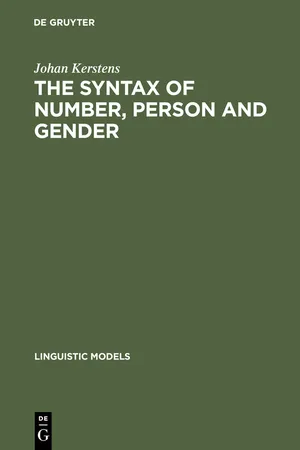
- 286 pages
- English
- PDF
- Available on iOS & Android
eBook - PDF
About this book
No detailed description available for "The Syntax of Number, Person and Gender".
Frequently asked questions
Yes, you can cancel anytime from the Subscription tab in your account settings on the Perlego website. Your subscription will stay active until the end of your current billing period. Learn how to cancel your subscription.
At the moment all of our mobile-responsive ePub books are available to download via the app. Most of our PDFs are also available to download and we're working on making the final remaining ones downloadable now. Learn more here.
Perlego offers two plans: Essential and Complete
- Essential is ideal for learners and professionals who enjoy exploring a wide range of subjects. Access the Essential Library with 800,000+ trusted titles and best-sellers across business, personal growth, and the humanities. Includes unlimited reading time and Standard Read Aloud voice.
- Complete: Perfect for advanced learners and researchers needing full, unrestricted access. Unlock 1.4M+ books across hundreds of subjects, including academic and specialized titles. The Complete Plan also includes advanced features like Premium Read Aloud and Research Assistant.
We are an online textbook subscription service, where you can get access to an entire online library for less than the price of a single book per month. With over 1 million books across 1000+ topics, we’ve got you covered! Learn more here.
Look out for the read-aloud symbol on your next book to see if you can listen to it. The read-aloud tool reads text aloud for you, highlighting the text as it is being read. You can pause it, speed it up and slow it down. Learn more here.
Yes! You can use the Perlego app on both iOS or Android devices to read anytime, anywhere — even offline. Perfect for commutes or when you’re on the go.
Please note we cannot support devices running on iOS 13 and Android 7 or earlier. Learn more about using the app.
Please note we cannot support devices running on iOS 13 and Android 7 or earlier. Learn more about using the app.
Yes, you can access The Syntax of Number, Person and Gender by Johan Kerstens in PDF and/or ePUB format, as well as other popular books in Languages & Linguistics & Grammar & Punctuation. We have over one million books available in our catalogue for you to explore.
Information
Table of contents
- Introduction
- Chapter 1: Preliminary Assumptions
- 1.1. Background: the Principles and Parameters framework
- Chapter 2: The Case System
- 2.0. Introduction
- 2.2. Case-selection
- 2.3. Conclusion
- Notes
- Chapter 3: Agreement
- 3.0. Introduction
- 3.1. Phi-features in pronouns
- 3.2. Phi-features in determiners
- 3.3. The structure of noun phrases
- 3.4. The nature of specifiers
- 3.5. The nature of nouns
- 3.6. A comparison with the DP-analysis
- 3.7. The lexical categories reconsidered
- 3.8. Conclusion
- Notes
- Chapter 4: Prenominal Adjectives
- 4.0. Introduction
- 4.1. The distribution of adjectives
- 4.2. The final schwa
- 4.3. Adjectival specifiers
- 4.4. Adjectival predicates
- 4.5. Adjectival arguments
- 4.6. More than one prenominal adjective
- 4.7. Deflected prenominal adjectives
- 4.8. Conclusion
- Notes
- Chapter 5: Numerals, Quantifiers, and other Prenominals
- 5.0. Introduction
- 5.2. The phi-features of quantifiers
- 5.3. Van die-constructions (or: paradigm-less van)
- 5.4. Conclusion
- Notes
- Chapter 6: Finite INFL
- 6.0. Introduction
- 6.2. Conclusion
- Notes
- Chapter 7: Non-finite INFL
- 7.0. Introduction
- 7.1. Infinitival verbs
- 7.2. Past participles (geVd)
- 7.3. The functional projection of traces
- 7.4. Conclusion
- Notes
- Appendix A: On the nature of derived words
- 0. Introduction
- 1. Compounds
- 2. ‘Small clause’ verbs
- 3. Conclusion
- Notes
- Appendix B: On the Interpretation of Tense
- 0. Introduction
- 1. Reichenbach’s tense system
- 2. A syntactically based tense system
- 3. Sentences with more than one tense
- 4. Conclusion
- Notes
- Appendix C: On the Representation of Verb Clusters
- 0. Introduction
- 1. The problem
- 2. The proposal
- 3. The facts
- 4. Some residual problems
- 5. Conclusion
- Notes
- References
- Index